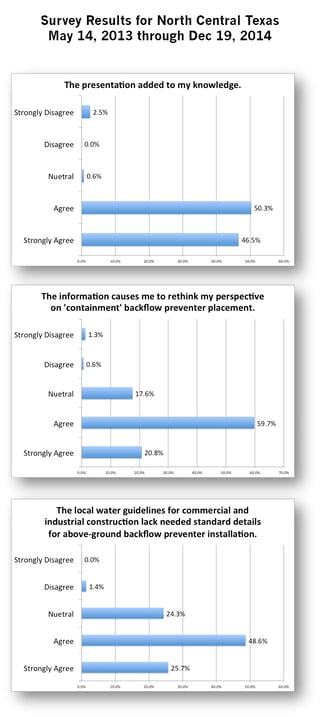Arlington Adds New Standard Details
Congratulations to Joe Gildersleeve, Water Resource Services Manager for the City of Arlington, Texas, for being the first in the north central Texas area to publish containment or "premise isolation" backflow preventer guidelines in the form of new standard details and drawings, for non-residential projects. This applies to new construction and renovations. Find these details, items 15A through 15J, here.
Local Engineers Speak Out
The need for updated design standards for this particular building system became evident following a survey of local civil and plumbing engineers. The results of this survey were presented to the city of
Arlington in February of 2015 revealing that more than 78% of local design engineers stated a need for standard details. The format of the survey was to make astatement and then  ask the local designer to reply in one of five ways: strongly agree, agree, neutral, disagree, or strongly disagree. Over the period, 1311 civil and plumbing engineers were contacted for response. One statement in particular was extraordinary: "Local water guidelines for commercial and industrial construction lack needed standard details for above-ground backflow preventer installations." Of those surveyed, over seventy-eight percent of the respondents agreed or strongly agreed, and less than two percent disagreed. See the full results of the survey to the right.
ask the local designer to reply in one of five ways: strongly agree, agree, neutral, disagree, or strongly disagree. Over the period, 1311 civil and plumbing engineers were contacted for response. One statement in particular was extraordinary: "Local water guidelines for commercial and industrial construction lack needed standard details for above-ground backflow preventer installations." Of those surveyed, over seventy-eight percent of the respondents agreed or strongly agreed, and less than two percent disagreed. See the full results of the survey to the right.
Head over to the local codes section of our website to look for your city's standard details.
Overcoming the Inertia of the Status-Quo
Central to the need for new design standards is the lack of clarity and understanding that design engineers face when attempting to specify the installation method sought by any given water utility. Moreover, the methods sought by many local plumbing authorities do not align with recognized best practices endorsed by leading trade groups such as the American Waterworks Association (AWWA) and the American Society of Plumbing Engineers (ASPE). This is not surprising. Within many water districts and city governments there is a very strong force at work. I call it the "inertia of the status quo". Utility and government personnel are not preoccupied with the same management benchmarks and iterative improvement objectives found in most businesses. This is not a criticism. Their roles are centered on asset management, resource-delivery efficiency, and to some extent, customer service. It is also fair to say that across the north-central Texas region, the observed effort ranges from poor to exemplary. Going through the difficult task of publishing an agreed-upon set of preferences for one installation method over another - especially when there is no difference in resource-delivery efficiency - tends to get moved down the priority list year after year. But a slow drip of incremental wisdom has accumulated over the past several years and a tipping point appears to have been reached.
Premise-Isolation is Essential
The Clean Water Act of 1972 started a slow but steady march to a more robust system of cross connection abatement when it's author, the Environmental Protection Agency (EPA) published its initial Cross-connection control manual (CCCM) in 1976. With revisions through 2006, it now exists as the preeminent guidance on the protection of the public water system from private water customers. The imperatives embedded in this guidance place extraordinary responsibilities on the local water district to control individual water gateways to customers. The language clearly conveys on the water purveyor the duty of ensuring that no delivered water will ever return to - and therefore be commingled with - the public water supply. As part of the introduction to the current published edition of the CCCM, the AWWA, the trade group representing the nation's water utilities, states,
“…. The return of any water to the public water system after the water has been used for any purpose on the customer’s premises or within the customer’s piping system is unacceptable and opposed by AWWA. …”
Given this mandate, water utilities all over the U.S. are adopting requirements for premise isolation using a backflow preventer assembly that meets the stringent performance specifications of the American Society of Sanitary Engineers (ASSE) and the University of Southern California Foundation of Cross Connection Control and Hydraulic Research (USC). More and more, it is becoming apparent that without a containment, or premise isolation system at the service connection, water utilities are unable to uphold their duty under the CWA statute.



